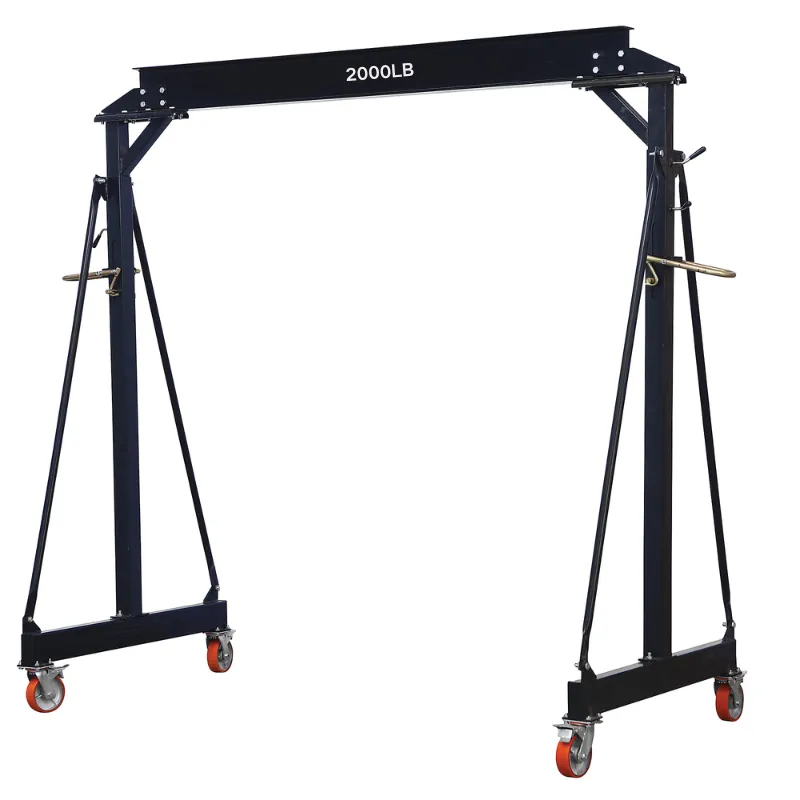1 ton gantry crane
The Significance of a 1 Ton Gantry Crane in Modern Industries
In recent years, the application of gantry cranes has become increasingly prevalent across various industries, due largely to their adaptability and efficiency in material handling. Among the different capacities available, the 1-ton gantry crane stands out as a robust solution to address the lifting needs of smaller-scale operations. This article delves into the significance of a 1-ton gantry crane and its impact on various sectors.
Understanding Gantry Cranes
A gantry crane is a type of crane that consists of a hoist, which is suspended from a beam, and is supported by legs on either side. Unlike traditional cranes, which may require extensive setup and specialized installation, gantry cranes can be relatively easy to assemble and disassemble. Their mobility, often featuring wheeled legs, allows for movement across various job sites, making them a versatile choice for diverse applications.
Key Features of the 1 Ton Gantry Crane
1. Lifting Capacity The 1-ton capacity ensures that it can efficiently handle loads such as machinery, equipment, and other heavy components in manufacturing and construction settings.
2. Mobility Many 1-ton gantry cranes are designed with wheels that allow operators to move them around the workshop or site as needed. This mobility is invaluable for dynamic work environments.
3. Adjustable Height Many models feature adjustable height settings, which provide flexibility to handle materials of varying sizes without compromising safety.
4. Cost-Effective These cranes offer a budget-friendly option for smaller companies or specific projects where heavy lifting is required but within a limited budget.
Applications Across Industries
1 ton gantry crane

1. Manufacturing In manufacturing plants, a 1-ton gantry crane can facilitate the lifting and positioning of heavy machinery, parts, and assemblies. It supports productivity by reducing the time workers spend manually handling materials.
2. Construction In construction, these cranes play a crucial role in lifting materials onto scaffolding or into position. Their versatility and ease of setup help streamline construction projects while ensuring safety standards are met.
3. Warehousing In a warehouse environment, a 1-ton gantry crane can aid in the efficient organization of inventory. The ability to lift heavy items reduces the risk of injury associated with manual handling.
4. Automotive The automotive industry also benefits from gantry cranes, particularly in repair shops where lifting engines or other heavy components is often necessary.
5. Electronics In electronics manufacturing, these cranes can safely lift and maneuver delicate components without the risk of damage, thus protecting both the product and the workers.
Safety Considerations
While handling heavy loads comes with inherent risks, the design of the gantry crane incorporates various safety features to mitigate such hazards. These often include safety locks on hoists, inspection protocols, and guidelines for proper usage. Training operators to understand weight limits, rigging procedures, and proper communication signals is crucial for ensuring safe operation.
Conclusion
The 1-ton gantry crane is an essential tool that enhances operational efficiency across multiple sectors. Its ability to lift, move, and position heavy loads makes it invaluable in manufacturing, construction, automotive, and warehousing industries, among others. As technology continues to advance, the design and functionality of these cranes are evolving, making them even more integral to modern operations. By providing safe, efficient, and cost-effective solutions to heavy lifting, the 1-ton gantry crane sets the stage for productivity and safety in the workplace, ensuring that industries can meet their demands promptly and effectively.
-
Unlock Seamless Relocation with Our Heavy Equipment Moving ExpertiseNewsJun.06,2025
-
Unleash Unrivaled Flexibility with Our Adjustable Gantry CraneNewsJun.06,2025
-
Unleash Heavy-Duty Efficiency with Our Industrial Gantry Crane SolutionsNewsJun.06,2025
-
Revolutionize Steel Handling with Our Magnetic Lifter RangeNewsJun.06,2025
-
Master Equipment Mobility with Premium Machinery Mover SolutionsNewsJun.06,2025
-
Elevate Your Material Handling with Magnetic Lifter TechnologyNewsJun.06,2025
-
YS Permanent Lifting Magnets: The Smarter Way to Handle SteelNewsMay.22,2025
